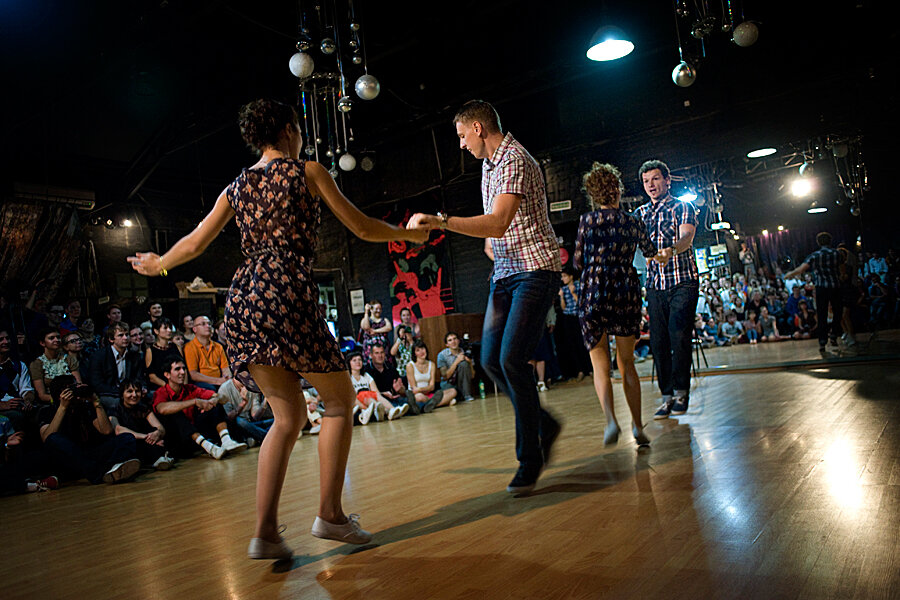Doing the Lindy for fun and exercise in Moscow
Loading...
| Moscow
As teenagers during the Soviet era, Sergey and Lyudmila Gubarev used to copy American-inspired songs onto cassette tapes that then made the rounds among their friends. The music on the tapes, spanning from the 1940s onward, offered them a peek through the Iron Curtain that closed off Western cultural imports.
Today, they still love the same American tunes, but it is not such a clandestine affair.
Sergey and Lyudmila, now both 40, dance swing and the Lindy Hop to keep “young and fit.” And they’re far from alone. Dance instructor Olga Moiseeva says she has seen a tenfold hike in the number of Muscovites wanting to twist and shake. Ten years ago, only three pupils would show up to one of her classes. Nowadays she arranges Lindy-Hop parties that draw hundreds of dancers.
"The Lindy Hop is about freedom," Ms. Moiseeva says. "And the music is fantastic. But it's about more than the dance, it's about taking classes, competing and, for some, about the cars and the fashion." A burgundy skirt, discrete pumps, and a champagne-colored rose in her wavy hair sets the glamorous Moiseeva apart from her students during a weeknight beginners' class. But once dancers are ready to compete, they ramp it up in the style stakes.
Muscovites going retro
It's Friday night. The air smells of hairspray. Gym bags line the room – a rehearsal space on the second floor of an anonymous theater just outside Moscow's city center – where about 50 dancers are getting ready. A group of women apply fake eyelashes by a floor-to-ceiling mirror while a young man adjusts a white tie over his black shirt. "A lot of people are inspired by American '40s and '50s culture and want to express that," says the evening's emcee, Nasdiya Murashko, clad in a navy-blue sailor dress with a wide A-line skirt.
Upstairs, in the dance hall, Pavel Sotnikov is getting ready to compete in a getup of tight jeans and a checkered shirt. His passion is early rock 'n' roll, but tonight it is all about the boogie-woogie. "This music wasn't very popular before, but there are more and more people discovering it, and there's more of a general interest in retro culture than five years ago," Mr. Sotnikov says.
A few competitors have already performed when Sotnikov and his three partners enter the dance floor. The music starts, and the quartet doesn't have a single step out of beat. The audience rewards them with thunderous cheers as the music wraps up, and the dancers throw kisses in the air in all directions.
"Sure, we might win," says a sweaty and elated Sotnikov, "but it doesn't matter. These people are my friends, I want to feel that sense of community with the audience."
Act follows act as the competition continues, mixing high and low, but mostly the competitors stick to the swing and Lindy Hop.
Taking it on the road
As the evening draws to a close, Sotnikov and his teammates are crowned winners. Yet their sights are already set on the next target – dance camps abroad.
"I'm in the habit of taking two weeks off every year to dance, usually a week in Sweden and the second week somewhere else. That's when I get to meet people from all over the world, which is the best thing about this scene," says Sotnikov.
He won't be going alone. The tiny town of Herräng in central Sweden is legendary in retro dance circles for its annual festival. "At this point we’re almost famous in Herräng," says one dancer, Oleg Rusakov. Like most middle-aged dancers in attendance, his fascination for Western pop culture began with furtive tape exchanges in the Soviet Union.
Roman Molkhanov, 24, is of another generation. He and his group of young dancers have traveled to Moscow from Tula, 120 miles south of the capital. Their eyes are also set on the Swedish dance camp. "We really want to go to Herräng. We don't have a lot of money but we're working hard to save up money to go."
Lindy-Hop instructor Moiseeva says Herräng is a nice change for Russian dancers. "It's a surprise for them, because we don't really have a dance culture in Russia – we sit and sing more than we get up and dance – so Herräng is light-hearted and fun for us. I try to copy Herräng here at my dance studio."







